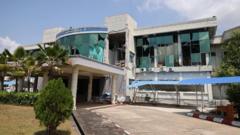Myanmar's capital, Nay Pyi Taw, will see its layout fundamentally altered due to the catastrophic earthquake that struck last month, according to the military leader, Senior General Min Aung Hlaing. During a recent government assembly, Hlaing noted that structures that collapsed were predominantly built on unstable soil, contributing to their failure during the quake. As part of the rebuilding initiative, all future office buildings must comply with new earthquake-resistant design standards and extensive soil testing will precede construction efforts. Reports indicate that around 70% of government properties suffered damage during the earthquake on March 28, which registered a magnitude of 7.7 and was felt significantly across neighboring regions, including Thailand and southwestern China.
The earthquake has had a tragic human toll, with official figures citing over 3,500 fatalities and 5,012 injuries. Nay Pyi Taw, a city with a relatively new history, was established in 2005 and is designed to serve as the country's administrative center, yet it has always been sparsely populated compared to its extensive infrastructure, which includes wide boulevards and lavish shopping plazas. The reasons for the city’s selection as the capital, situated 370km inland from the larger city of Yangon, remain a topic of debate.
Since the military coup in 2021, Myanmar has been ensnared in civil conflict, with ongoing clashes between the junta and various ethnic militias. In an effort to facilitate rescue and relief actions, a temporary ceasefire was declared on April 2; however, reports suggest military operations against rebel zones have persisted. Recent images from the military's photo archives reveal extensive devastation to key government buildings, including the Ministry of Labour and the Court of the Union.
Many edifices stand in disrepair with no repair efforts underway, prompting the relocation of significant governmental operations to Yangon, 366km away. Despite the challenges, ministries are also adapting by moving into alternative open-air facilities known as "hotai" in Nay Pyi Taw, uniquely designed with steel frames to mitigate earthquake risks. Meanwhile, efforts are ongoing by staff at the National Museum to salvage invaluable collections of texts and manuscripts amid the destruction.

















